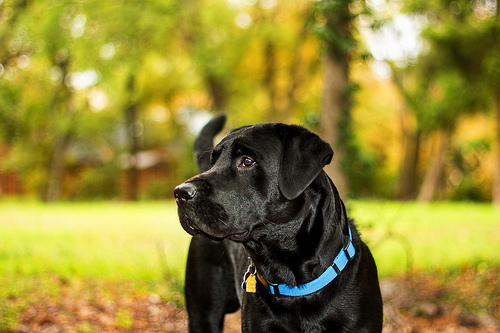Lost Pet Recovery 101
by Ontario SPCA and Humane Society | General Pet Care | March 21, 2019
As loving and devoted pet owners, we rarely expect to lose a pet. Yet each year, more than 10 million pets go missing in North America and more than 75 percent never return home. The simple truth is that it only takes an instant for a pet to go missing – a door or gate left open, a car accident, or one of many other unforeseen events. Thankfully, you can help protect your pets by understanding lost pet behaviour, effective search tactics and critical loss prevention techniques.
When searching for your cat, consider
Your cat’s territory. If your indoor cat escapes outside she is likely nearby, hiding in silence. Far from her territory (the inside of your home), she will try to avoid detection from predators. Consequently, she may not respond to your calls. Beware: If your cat is not found quickly, she may be frightened further away (e.g. another animal chases her).
If your outdoor-access cat fails to come home, it’s likely that something has happened to prevent or interrupt her return. She may be nearby but trapped, injured, or, sadly, deceased. If your cat is chased out of her territory, she may be a few houses (or blocks) away, hidden and too fearful or disoriented to make her way back.
Consider the possibility that your cat may have been transported outside of her territory after climbing into an open car or service vehicle. Ask your neighbours if they saw any unusual vehicles in the area.
Your cat’s personality.
If your cat is cautious or aloof she will likely seek immediate concealment. It may take several days or more before she gains enough confidence (or is motivated by hunger) to venture home, or to travel. If your cat is outgoing and fearless she will likely hide briefly, before gaining confidence and traveling. Regardless of your cat’s personality, the most important thing to do is to act quickly and look thoroughly! Your cat may be using shrubbery, decks, culverts or any other object to conceal herself. Do not expect your cat to respond to your calls. Your cat’s silence may protect her from predators, but it also endangers her life if you give up searching prematurely.
When searching for your dog, consider
Your dog’s travel path. Mild weather will increase the distance your dog is likely to travel. Highly populated areas increase the chances of your dog being found nearby since he is more likely to come into contact with people. Terrain (e.g. heavy brush, cliffs) will influence your dog’s path. Most dogs will follow the path of least resistance.
If your dog bolted in panic, such as from fireworks or a car accident, he may run for several kilometers or more before stopping and seeking a concealed area to hide. A dog that has escaped a yard to follow a scent is more likely to be found closer to home, doubling-back on the trail of yet another scent.
Your dog’s personality.
If your dog is aloof or fearful he is likely to avoid people, and to seek a concealed area to hide, such as a forest. He may be tempted to accept human contact only after someone has gradually earned his trust or he becomes motivated by hunger.
If your dog is friendly he is more likely to be found closer to home because he will likely seek attention from people and looks less threatening to approach.
Your method of approach.
When you spot your dog, NEVER yell or run directly at him. You will likely cause your dog to run further away. Do not punish him. To lure your dog closer, drop to the ground, turn away from him slightly, and call his name encouragingly. Offer a nice, smelly treat. If he doesn’t move towards you, you can approach him in an arc (do not approach directly) and with your hip towards your dog. Speak in a happy tone.

If that fails, a playful dog can often be enticed if you call his name and run AWAY from him in the opposite direction (be careful that there is no traffic when you try this). When he catches up, drop to the ground (still facing away from him) and reach for his collar, under (not over) his head.
If your dog is trained, you can call out “Come” “Sit” or “Stay” etc., and he may respond.
6 Effective Search Tactics
- Immediately search your property and your neighbours’ properties (with permission) in a five-house-radius. Expand outwards as needed. Walk the neighbourhood, talk to everybody, and leave your phone number and pet’s description or photo. Make noise while you walk around by calling, squeaking a toy, shaking a kibble bag etc. Bring a tasty treat, harness, leash and/or cat carrier to secure your pet.
- Place strong-scented articles outside your home, such as her bedding, to lure her home.
- Change your voicemail message to include a description of your missing pet and how to reach someone during the day and night. Check it regularly. Lost pets can move quickly.
- Visit local Ontario SPCA Branches, Humane Societies and Animal Control and leave your phone number and a picture of your pet. Call local veterinarian offices during the day, and after 5 p.m. call animal emergency clinics. Check back regularly, and visit often to view the stray animals. Staff may not recognize your pet based on the description or photo you’ve provided.
- Place missing pet signs at major intersections (and veterinary offices, stores etc.) within a two kilometer radius (or minimum five block radius), expanding outwards within a few days if your pet has not been found. For great poster tips visit www.lostapet.org/recovery-posters.php. Remove the posters once your pet is found.
- Place an ad in your local newspaper and check the “found” ads every day. Some “strays” are eventually posted onwww.petfinder.com and other websites.
Loss Prevention: Keep Your Pets Safe!
Shelters across Ontario receive thousands of stray animals each year – many without identification. Identification is the best way to ensure that your lost pet can be reunited with your family!
- Microchip, collar and tag your pet (include owner contact information so your pet can be returned even if veterinary or animal control offices are closed).
- Keep your cat indoors! To help your outdoor cat learn to appreciate the great indoors see our animal care fact sheet “Pet Safety- Keeping Cats Safe”
- Secure your property. Repair small holes and loose boards in fencing or add height to a low fence. Prevent your dog from digging out by putting chicken wire from the bottom of the fence sloping downwards and inwards, or sink bricks (or large stones) along the fence line.
- Supervise and make the backyard more exciting to your dog by giving him stuffed Kong toys to chew on and by spending time together playing fun cooperative games.
- Secure your pets during transport using crates, harnesses and leashes.
- Use positive training to increase your dog’s chances of responding to your request to “Come.”
- Spay or neuter your pet! In addition to many health benefits, your pet will be less likely to roam.
- Prepare a lost pet kit in advance with some up-to-date photos and posters so you can act quickly if needed.
- Train your pet to associate a pet whistle with meals by blowing just before you feed him. If he ever gets lost, you will increase the chances that your pet will respond to your search efforts.
For more information about finding a lost pet visit www.lostapet.org.
Categories
Testimonial
Dogs only ask for your love and attention
Dogs only ask for your love and attention, nothing else. Thank you for everything you do!

